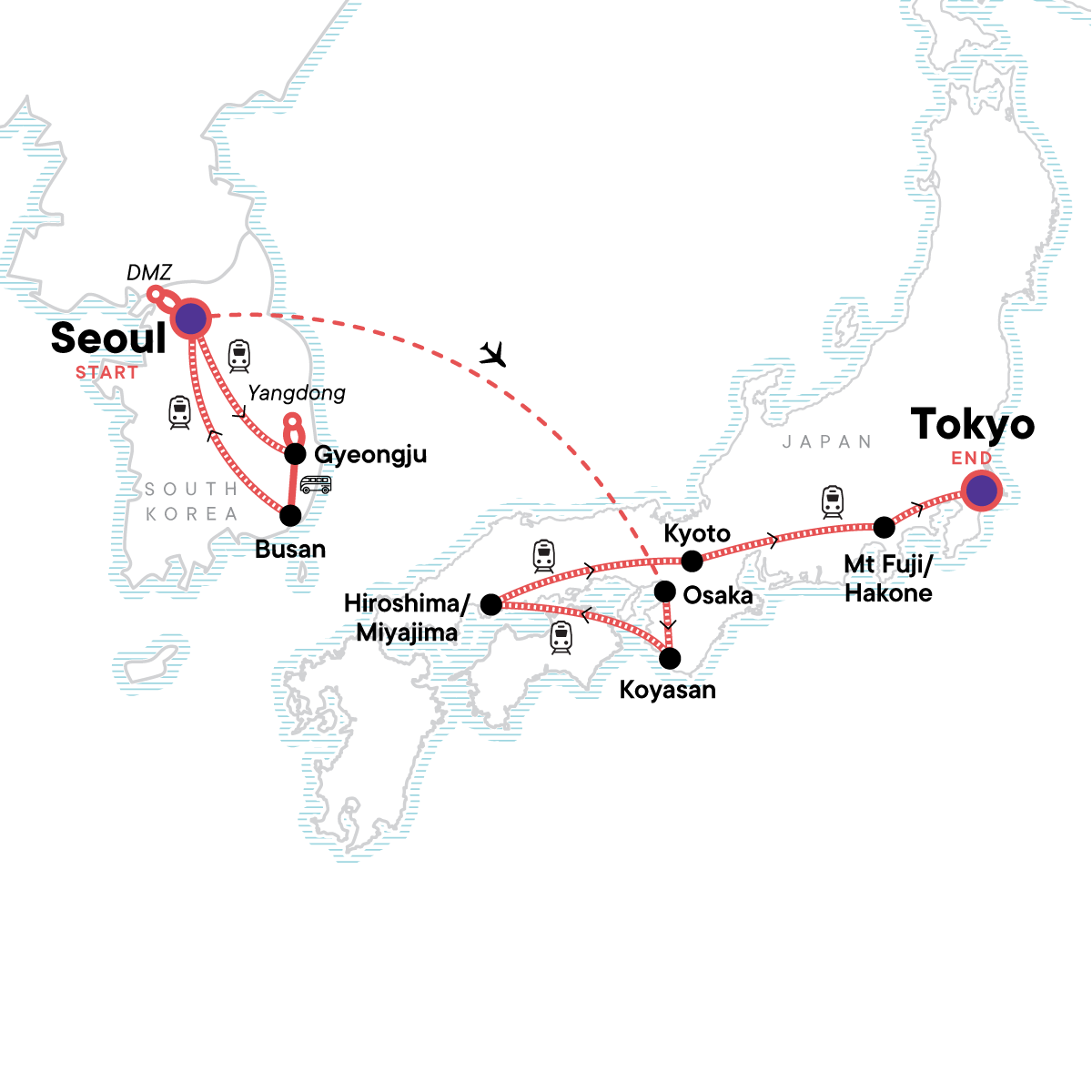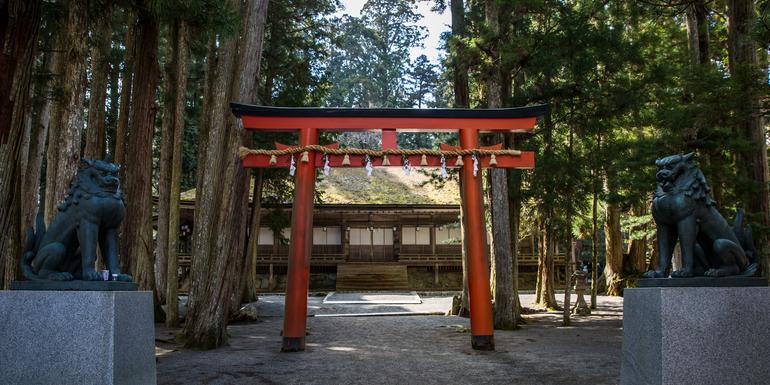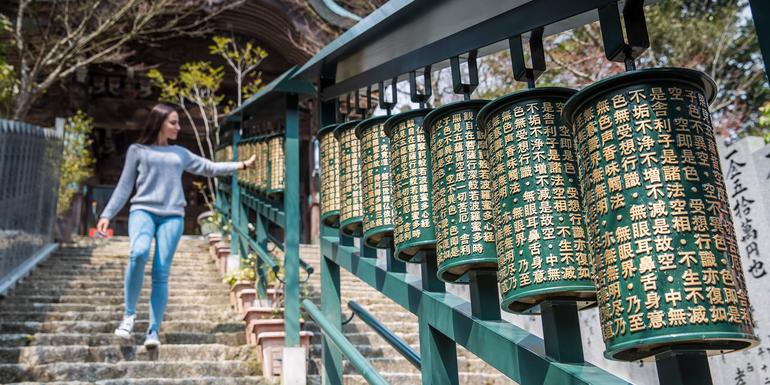Korea & Japan Encompassed
- Trip code: 437X012
- Dauer: 16
- Stil: Classic
There's truly no better way to see living ancient traditions and futuristic marvels perfectly coexisting than on an adventureful two weeks through South Korea and Japan. Hit iconic destinations and try life-changing street food in both countries. Stay overnight in a temple tucked away in the Korean mountainside and in a traditional Japanese ryokan inn. Come hungry and get ready for an unforgettable trip through two of Asia's most popular destinations.
Übersicht
Accommodation
Hotels (13 nts), mountain monastery (1 nt, shared facilities) temple (1 nt)
Checklist
Cold Weather:
• Long-sleeved shirts or sweater
• Scarf
• Warm gloves
• Warm hat
• Warm layers
• Warm waterproof jacket
Documents:
• Flight info (required) (Printouts of e-tickets may be required at the border)
• Insurance info (required) (With photocopies)
• Passport (required) (With photocopies)
• Vouchers and pre-departure information (required)
• Visas or vaccination certificates (With photocopies)
Essentials:
• Toiletries (required) (Shampoo, bodywash, soap, etc.)
• Binoculars (optional)
• Camera (With extra memory cards and batteries)
• Cash, credit and debit cards
• Day pack (Used for daily excursions or short overnights)
• Ear plugs
• First-aid kit (should contain lip balm with sunscreen, sunscreen, whistle, Aspirin, Ibuprofen, bandaids/plasters, tape, anti-histamines, antibacterial gel/wipes, antiseptic cream, Imodium or similar tablets for mild cases of diarrhea, rehydration powder, water purification tablets or drops, insect repellent, sewing kit, extra prescription drugs you may be taking)
• Flashlight/torch (Headlamps are ideal)
• Fleece top/sweater
• Footwear
• Hat
• Locks for bags
• Long pants/jeans
• Moneybelt
• Outlet adapter
• Personal entertainment (Reading and writing materials, cards, music player, etc.)
• Reusable water bottle
• Shirts/t-shirts
• Sleepwear
• Small travel towel
• Sunglasses
• Swimwear
• Watch and alarm clock
• Waterproof backpack cover
• Windproof rain jacket
Health & Safety:
• Hand sanitizer (required)
• Face masks (Clients will be only be required to wear a face mask where it is mandated by local regulations.)
• Pen (Please bring your own pen for filling out documents.)
Warm Weather:
• Sandals/flip-flops
• Shorts/skirts (Longer shorts/skirts are recommended)
• Sturdy water shoes/sandals
• Sun hat/bandana
• Swimwear
Group Leader
CEO (Chief Experience Officer) throughout, local guides
Group Size Notes
Max 16, avg 12
Highlights
Immerse yourself in the serene and spiritual atmosphere with an overnight stay at a traditional temple, Experience Japanese hospitality and tradition with a stay in a cozy ryokan. Enjoy leisure time exploring the vibrant attractions, cuisine, and culture of both Tokyo and Seoul, Reflect on history and hope for peace at Hiroshima Peace Park, Walk through the iconic red torii gates of the stunning Fushimi Inari Shrine
Introduction
There's truly no better way to see living ancient traditions and futuristic marvels perfectly coexisting than on an adventureful two weeks through South Korea and Japan. Hit iconic destinations and try life-changing street food in both countries. Stay overnight in a temple tucked away in the Korean mountainside and in a traditional Japanese ryokan inn. Come hungry and get ready for an unforgettable trip through two of Asia's most popular destinations
Meals Included
10 Frühstück, 3 Abendessen
Meal Budget
Plane USD555-725 für nicht inbegriffene Mahlzeiten ein
Optional Activities
Seoul
- Gwangjang-Markt
- Besuch im historischen Museum von Seoul (Gratis)
- N Seoul Tower Observatorium (16000KRW pro Person)
- Besuch im Stadtviertel Gangnam
- Besuch der Schwimmenden Insel
- Regenbogenwasserspiel an der Banpo-Brücke (Gratis)
- Kimchi & Hanbok-Erlebnis (25-89USD pro Person)
- Samsung Leeum Gallery
- Besuch im Stadtviertel Itaewon (Gratis)
Gyeongju-si
- Anapji-Teich (3000KRW pro Person)
- Fahrradverleih – Gyeongju (5000KRW pro Person)
Busan
- Busan Tower Observatorium (12000KRW pro Person)
- Jjimjilbang
- Karaoke
Miyajima
- Besuch des Mount Misen (Free-1840JPY pro Person)
Kyoto
- Zen-Garten des Ryōan-ji (500JPY pro Person)
Tokyo
- Shopping in Ginza (Gratis)
- Spaziergang im Ostgarten des Kaiserpalastes (Gratis)
- Besuch im Ueno-Park (Gratis)
- Besuch des Meiji-Schreins (Meiji Jingū) (Free-1000JPY pro Person)
Asakusa
- Besichtigung des Tempels Sensō-ji (Gratis)
Start / Finish
Seoul nach Tokyo
What's Included
Dein Welcome-Moment: Anreise und Begrüßungstreffen
Dein Local-Living-Moment: Overnight Temple Stay, Gyeongju-si
Dein Local-Living-Moment: Übernachtung im Tempel am Kōya-san, Kōyasan. City tour of Seoul. DMZ visit. City tour of Gyeongju. Yangdong Folk Village visit. Haedong Yonggungsa Temple Visit. City tour of Busan. Haeundae Beach and Dongbaek Island (APEC House) Visit. N Seoul Tower Visit. Namdaemun Market Visit. Hiroshima Peace Park and Museum visit. Miyajima Island excursion. Nijo Castle and gardens visit. Gion walk. Fushimi Inari shrine visit. Lake Ashino-ko boat ride. Traditional kaiseki meal. All transport between destinations and to/from included activities
Minimum Age
Um ohne Begleitperson mit G Adventures zu reisen, musst du mindestens 18 Jahre alt sein. Das Mindestalter für Kinder in Begleitung eines Erziehungsberechtigten (über 21) beträgt 12 Jahre
Itinerary
Day 1 Seoul
Welcome to Seoul! As fellow travellers are arriving throughout the day, there are no planned activities until a group meeting at 6 pm. Check into the hotel and enjoy the city
Day 2 Seoul
Sit back and relax on a private bus and enjoy a tour of the bustling metropolis where modern skyscrapers, high-tech subways and pop culture meet Buddhist temples and street markets. Visit Gyeongbokgung Palace, the National Folklore Museum, Bukchon Hanok Village and Insadong alley
Day 3 Seoul/Gyeongju-si
After breakfast, board a high speed bullet train for a relaxing morning ride through the countryside to Gyeongju. Once the group arrives to this old capital city for 1,000 years, they will experience an overnight stay in a local temple. During the stay the group will learn about temple etiquette, watch a monk martial arts performance, experience the daily prayer ritual and a temple style dinner
Day 4 Gyeongju-si
Enjoy a peaceful morning meditation, martial arts practice, and drum and bell ritual before exploring in Gyeongiu. On the city tour visit to the UNESCO site of Bulguksa Temple located on the slopes of Mount Toham and admire the national treasures there, such as Dabotap and Seokgatap stone pagodas, Cheongun-gyo, and two gilt-bronze statues of Buddha. Afterwards, experience the oldest surviving astronomical observatory in Asia, Cheomseongdae Observatory, and the surrounding Royal Tombs
Day 5 Gyeongju-si/Busan
Travel by bus to Busan. Along the way enjoy a day trip to Yangdong Folk Village, a 500-year-old UNESCO site located in Gyeongju National Park, to get a feel for life during the early Joseon Dynasty. Afterwards, continue on to the picturesque 14th century seaside temple hidden in the rocks - Haedong Yonggungsa. After exploring the temple, check in to your hotel and get your bearings with an orientation walk on Haeundae Beach and Dongbaek Island (APEC House). Spend the evening getting to know colourful Busan, opt to treat yourself at a Jjimjilbang spa or sing your heart out at a popular karaoke bar
Day 6 Busan/Seoul
In the seaside city, Busan, visit the bustling Jagalchi fish market, Gukjesijang market, Yongdusan Park, and the colourful Gamcheon Culture Village before traveling back to Seoul. After arriving in Seoul by train, check out Korea's oldest traditional market - Namdaemun Market. Then make your way by cable car to N Seoul Tower to see this beautiful landmark and opt to make the trip up to the observation deck. Spend the rest of your day in Seoul opting to see Banpo Bridge, the floating islands, or hanging out in the Gangnam district
Day 7 Seoul
Visit the Demilitarized Zone (DMZ), founded in 1953, separating North and South Korea. With over a million soldiers on watch each day, it is one of the last remnants of the Cold War. With a buffer zone 4km wide and spanning 250 km long there has been very little development in the area, therefore nature and wildlife have pretty much taken over. Spend about 3-4 hours visiting the Demilitarized Zone, then head to The War Memorial of Korea. Later, return back to Seoul for another night in the city
Day 8 Seoul/Osaka
Say annyeong to South Korea and konnichiwa to Japan as we depart one incredible place and start our adventure in a new one. Upon arrival in Osaka, take some time to rest or explore on your own. There aren't any activities today until the evening where you'll join your CEO and great for a Japan Welcome Meeting
Day 9 Osaka/Kōyasan
Kōya-san Besuche das Zentrum des Buddhismus in Japan und übernachte in einem Tempel auf dem 800 m hohen Kōya-san. Lass dir ein traditionelles Abendessen der vegetarischen buddhistischen Küche (Shojin Ryori) schmecken
Day 10 Kōyasan/Hiroshima
Beobachte die Mönche beim morgendlichen Gebet und genieße ein traditionelles Frühstück, bevor du nach Hiroshima weiterfährst
Day 11 Hiroshima
Nimm die Fähre zur heiligen Insel Miyajima, um das berühmte schwimmende Torii zu sehen. Optionale Wanderung rund um Mt Misen
Day 12 Hiroshima/Kyoto
Reise nach Kyoto und beginne damit, die Stadt zu erkunden. Besuche die eindrucksvolle Burg Nijo und ihre Gärten, eine UNESCO-Welterbestätte. Genieße am Abend einen vom CEO geführten Spaziergang durch das Geisha-Viertel Gion
Day 13 Kyoto
Besichtige den wunderschönen Fushimi Inari Taisha-Schrein und schlendere durch die leuchtend roten Torii-Tore. Du hast außerdem Gelegenheit zum Einkaufen, für einen Spaziergang am Flussufer oder um einen weiteren der zahlreichen Tempel in Kyoto zu besichtigen
Day 14 Kyoto/Hakone
Unternimm eine Bootsfahrt auf dem See Ashino-ko. Mit etwas Glück hast, siehst du sogar den Fuji. Wo du eine mehrgängige japanische Kaiseki-Mahlzeit genießen, in die natürlichen Thermalquellen eintauchen
Day 15 Hakone/Tokio
Weiterfahrt nach Tokio. Zeit zur freien Verfügung, um letzte Einkäufe zu tätigen
Day 16 Tokio
Abreise zu jeder Zeit möglich
Detailed Itinerary

Day 1 Seoul
After the welcome meeting, join your CEO for an orientation walk down Cheonggyecheon Stream to learn about Seoul while walking past small waterfalls and nearly two dozen overhead bridges. Then, enjoy the dense grid of streets found in the bustling neighbourhood of Myeongdong which is packed with people at all hours of the day looking to enjoy some of the best shopping, street food, and nightlife in all of Korea.
Opt for a group dinner to end your first night! The most convenient way to get around South Korea is by public transportation and on foot. The country's train system is world renowned so the majority of our trips utilize this efficient train network. In this tour, you will need to be able to spend the majority of the day on your feet and carry your luggage through busy train stations and streets. Please ensure you are fit enough to carry your own luggage and spend most of the day on your feet
Day 2 Seoul
After exploring the city, opt to see a show, explore a local museum, or hit the pavement and eat your way through street markets trying local fares such as bibimbap, soondae, and kimchi.
Day 3 Seoul/Gyeongju-si
Stay in rooms called Ondol. These rooms are very traditional, heated to be cozy and comfortable, with beds made up directly on the floor. The rooms here are multi-share, divided up by male and female rooms. Enjoy a traditional dinner and breakfast during the stay.
Have the opportunity to learn about temple etiquette, experience the daily drum and bell ritual and take an easy hike up to the only stone cave temple in Korea for morning meditation.
Day 4 Gyeongju-si
Day 5 Gyeongju-si/Busan
Day 6 Busan/Seoul
Day 7 Seoul
Opt to visit the Samsung Leeum Contemporary Gallery, explore the Itaewon neighbourhood, or prebook the Kimchi making and Hanbok experience.
Day 8 Seoul/Osaka
Day 9 Osaka/Kōyasan
Fahrt zum religiösen Zentrum Koya-san, das im Jahr 816 vom buddhistischen Mönch Kobo Daishi gegründet wurde. Die Zugfahrt hinauf zum Berg ist möglicherweise eine der schönsten Bahnreisen in Japan. Den letzten steilen Anstieg bewältigen wir mit einer Standseilbahn, bevor es mit dem Bus weiter zum Kloster geht.
Lass dir abends die typische vegetarische Küche „Shojin-ryori“ schmecken. Anschließend kannst du in einem Yukata oder Kimono entspannen. Please note, you will not have access to your main luggage for approximately 24 hours, as we utilize Japan’s takkyubin service to conveniently and reliably transfer luggage from Osaka to Hiroshima and avoid hauling large bags on crowded trains. You must pack an overnight bag with everything you’ll need until you’re reunited with your luggage the following day
Day 10 Kōyasan/Hiroshima
Early morning offers the chance to observe the monks praying. Breathe in some fresh mountain air before a vegetarian breakfast, then start the journey back down the mountain via bus, train and funicular.
Later, board a train to Hiroshima, a historically significant city, marked by the explosion of the first atomic bomb in 1945.
Day 11 Hiroshima
Day 12 Hiroshima/Kyoto
Please note the Ninomaru Palace at Nijo Castle will be closed from Dec 26-Jan 3. Groups travelling during this time will visit the Kiyomizu-dera Temple
Day 13 Kyoto
Day 14 Kyoto/Hakone
Wir reisen nach Hakone, eine Stadt in den Hügeln, die für ihre Onsen bzw. natürlichen Thermalquellen berühmt ist.
Verbringe den Abend im Ryokan, wo du dir eine aufwändige Mahlzeit aus traditionell japanischen Speisen schmecken lässt. Anschließend kannst du im Onsen entspannen, was wirklich empfehlenswert ist. Please note, you will not have access to your main luggage for approximately 24 hours, as we utilize Japan’s takkyubin service to conveniently and reliably transfer luggage from Kyoto to Tokyo and avoid hauling large bags on crowded trains. You must pack an overnight bag with everything you’ll need until you’re reunited with your luggage the following day
Day 15 Hakone/Tokio
Wir kommen vormittags in Tokio an, und du hast Zeit, diese dynamische Metropole zu erkunden.
Optional kannst du den Ueno-Park und seine Museen, den Bezirk Akihabara für hochmoderne Elektronik, das Stadtviertel Harajuku für flippige Mode oder den Stadtteil Ginza für das Beste vom Besten besuchen, das Gelände des Kōkyo Higashi-gyoen (Ostgarten des Kaiserpalastes) erkunden oder einfach durch die Straßen schlendern, um einen Blick auf das traditionelle Leben zu erhaschen, das sich immer noch unter der modernen Oberfläche abspielt.
Day 16 Tokio
Wir empfehlen die Buchung von zusätzlichen Übernachtungen nach Ende der Tour, um diese pulsierende Stadt voll erleben zu können






